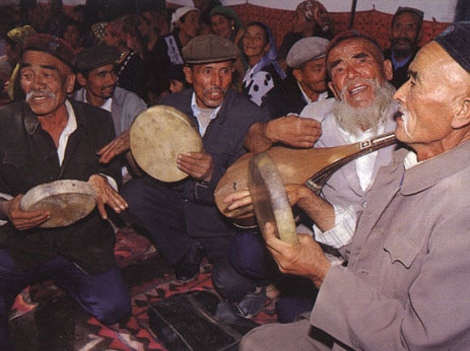
There is a great variety of different folk dances existing among the Uygur people in Kumul, all of which have a long history and unique characters. The obvious characters can help us easily tell the Kumul dances from other kinds of dances in Xinjiang Uygur Autonomous Region. To introduce the folk dances among Uygur people in Kumul, we should first talk about the Mashrap, which is popular among the common Uygur people living in the vast farming and stockbreeding areas. Max is the only form of a kind of entertaining activity of Uygur people. Mashrap, meaning evening party in Uygur language, is the main form to show the Maqam, folk songs, dances, folk art forms, dramas, acrobatics, games and oratures of Uygur people. It is also a very important way for common people to inherit, pass on and develop the moral power, folk customs, rituals, cultures arts and so on. Mashrap plays an important role in maintaining the Uygur traditions and folk customs. For thousands of years, Uygur people in Kumul perform all kinds of folk arts on the unique Mashrap, so that these art forms can be passed on generation by generation.
Maxrap is the name of a dancing and entertaining activity form, meaning the mass entertainment event that a lot of people take part in to entertain themselves. The main part of it is dancing. Maxrap can be classified according to different criteria. One classification is sing and dancing Maxrap, the game Maxirap and the rap Maxrap. Another classification is the parlor Maxrap, the greeting Maxrap and the harvest Maxrap. The most common one is the harvest Maxrap. All parts of Kumul have their own Maxrap with similar features and a similar style. However, the most typical one is the Doulan people. The Doulan Maxrap is bold, intense and unres Train ed. In the Doulan Maxrap, everyone will seize the opportunity to enjoy the dancing. Playing games is an essential part of Doulan Maxrap, the most commonly-seen of which is Grabbing Belt. Usually, it need two person to lay this Grabbing Belt. One person should try to whip the other one with the belt; however, the other one should try to grab the belt while avoiding the whip. The one who has the belt in his/her hands has the right to choose his/her partner in the game.
People can hold the Maxrap in the courtyard, or under the grape trellis, or in the orchard, or just on the grassland. The number of people taking part in it can range from ten or twenty, to several hundred. Even more than a thousand people are ok. No matter how many people are there, everyone takes the Maxrap as a big event. Decided by the host and the organizers, they can hold the Maxrap either during the day or in the evening. At the appointed time, people come to the Maxrap, greet each other, shake hands with each other and take seats according to the order. Everyone immersed in the happy and harmonious atmosphere.
Doulan Maxrap
Doulan Maxrap is the Maxrap popular among Doulan people. Doulan People live in the west of Tarim Basin, north bank of Yarkand River and both banks of Tarim River. Due to the different living environment and cultural background, the unique Doulan Maxrap took shape here. Doulan people living in the middle and lower reaches of Yarkand River are the descendants Mongolian people in the history. They are incredibly crazy about singing and dancing. Sometimes, when hearing the sound of music, the famers in the field will immediately put down their farm tools and dance to the music excitedly. So will the passers-by walking in the road. Makit County, located in the southwest of Xinjiang Uygur Autonomous Region, is a typical Uygur community. 89% of its population is Doulan people who are good at singing and dancing.
Doulan Maxrap mainly reflects the hunting, harvest and happy life etc. of Uygur people living in Doulan area. It contains many parts, like Doulan Maqam singing, entertainment dance, literary performance, art performance, different kinds of games and so on. It cannot be restrained by the environment condition, the time or the number of people. Doulan Maxrap has strict procedure, various kinds and colorful content. According to its character and function, Doulan Maxrap can be divided into four types, which are ceremonial rituals and life rituals, husbandry production, social activity and other folk customs.
Significance
Doulan Maxrap dance has countless changes, with an outburst of enthusiasm. The number of people taking part in it can be very big, without the restriction of time and location. As a result, Doulan Maxrap becomes the way to nourish folk artist of Doulan Maxarap and cultivate the taste of Doulan people. It all along maintains the strong natural characters of the traditional songs and dances in Tarim Basin. It is an important part in the daily life of Doulan Uygur people.
Doulan Maxrap is the encyclopedia to study the history, social life and spirit of Doulan Uygur people. Researches on Doulan Maxrap can help discover, protect and pass on the Doulan Maxrap culture, and thus promote the cultural and ideological progress in Xinjiang Uygur Autonomous Region, enrich Xinjiang people's cultural life, improve the quality of Xinjiang people and seek people's overall development. In addition, the protection and development of Doulan Maxrap will contribute a lot to building a harmonious socialist society.
Urgency to Be Included in the Protection List
Macrap was included in the State Council approved the second batch of national intangible cultural heritage protection project list on June, 14th, 2008. On November, 15th, 2010, the UNESCO (United Nations Educational Scientific and Cultural Organization) Intergovernmental Committee for the Safeguarding of the Intangible Cultural Heritage approved China's application. Maxrap was included into the "Masterpieces of the Oral and Intangible Heritage List That Need Urgent Protection" of the year 2010.



